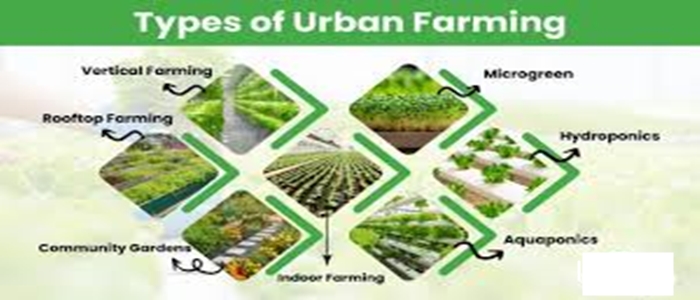The Types Urban Farming:
Definition
In this post, we discussed the meaning of urban farming, the features, the examples, the types, we also stated the benefits.
Definition
Urban farming refers to the practice of cultivating, processing, and distributing food within urban areas, surrounding activities like animal husbandry, aquaculture, and beekeeping. It goes beyond just growing food for personal consumption and often involves community initiatives and even commercial production. Essentially, it’s about bringing agriculture into the city, utilizing available green spaces and innovative techniques to produce food within the urban environment.
Features of Urban Farming:
Food Production in Urban Areas:
Urban farming involves cultivating crops within city limits, rather than relying solely on rural farms.
Variety of Locations:
Farming can occur in various urban settings, such as rooftops, backyards, balconies, community gardens, and even vertical gardens.
Food Security and Access:
It helps address food insecurity by providing fresh, local food within urban areas.
Reduced Carbon Footprint:
By shortening the distance food travels, urban farming reduces transportation-related greenhouse gas emissions.
Green Urban Spaces:
Urban farming contributes to creating greener and more sustainable urban environments.
Some Examples Urban Farming:
Community Gardens:
These are shared plots of land where residents can grow their own food together, fostering a sense of community and providing access to fresh produce.
Rooftop Farming:
Utilizing unused roof space to cultivate crops, offering a space-efficient solution for urban food production.
Vertical Farming:
Growing plants in stacked layers, maximizing space and reducing reliance on traditional farmland.
Aquaponics:
A system that combines aquaculture (raising aquatic animals) with hydroponics (growing plants in water), creating a sustainable and resource-efficient food production method.
Hydroponics:
Growing plants without soil, using nutrient-rich water solutions to provide essential elements for plant growth.
Indoor Farms:
Utilizing controlled environments, such as greenhouses or hydroponic systems, to grow food indoors, providing year-round food production and reducing reliance on external weather conditions.
The Types Urban Farming:
Community Gardens:
Shared spaces where residents cultivate crops, fostering social connection and providing access to fresh produce.
Rooftop Farms:
Utilizing building tops for growing crops, offering space-efficient agriculture and recreational opportunities.
Indoor Vertical Farms:
Utilizing hydroponics, aeroponics, or geoponics to grow crops in vertically stacked layers within controlled environments, maximizing space and production.
Hydroponics:
Growing plants without soil, using nutrient-rich water solutions, which is space-efficient and adaptable to urban settings.
Aquaponics:
Combining hydroponics with aquaculture, where fish waste provides nutrients for plants, creating a closed-loop system.
Backyard Gardens:
Transforming private yards or patios into productive gardens, providing fresh produce and promoting green spaces.
Beekeeping:
Supporting pollination and honey production within urban areas, contributing to biodiversity and food security.
Edible Landscaping:
Incorporating edible plants into landscaping designs, integrating food production with aesthetics.
Container Farming:
Growing plants in containers, suitable for limited spaces and adaptable to different environments.
Microgreens:
Cultivating small, leafy greens with a short growing cycle, suitable for urban farms and vertical agriculture.
The Benefits of Urban Farming:
- Food Security and Sustainability:
Reduced reliance on long-distance food transport:
Urban farming minimizes the distance food travels, reducing transportation costs, carbon emissions, and potential spoilage.
More reliable food supply:
Localized production helps ensure a more consistent and reliable supply of fresh produce, especially in the face of disruptions to traditional supply chains.
Increased access to healthy food:
Urban farms can provide access to affordable and nutritious fresh produce, particularly in underserved areas.
- Economic Benefits:
Stimulates local economies:
Urban farming creates jobs and generates income within the community, boosting local economic activity.
Supports local businesses:
Local farmers can sell their produce at farmers markets or directly to residents, strengthening the local food system.
- Environmental Benefits:
Reduces carbon footprint:
By minimizing transportation distance, urban farming helps lower greenhouse gas emissions associated with food production.
Creates green spaces:
Urban farms can transform vacant lots and rooftops into productive, green spaces, improving urban aesthetics and potentially reducing the urban heat island effect.
Conserves natural resources:
Urban farms can use innovative techniques like hydroponics and aquaponics to reduce water usage and soil dependence.
- Social and Community Benefits:
Promotes healthy eating:
Urban farms can educate residents about healthy eating habits and nutrition, fostering a culture of healthy food choices.
Engages communities:
Urban farming provides opportunities for community involvement, education, and social interaction.
Creates social connections:
Shared gardening experiences can strengthen community bonds and foster a sense of collective responsibility.
Conclusion
Urban farming involves cultivating food and raising livestock within or on the outskirts of cities. It encompasses various practices like rooftop gardens, vertical farms, and hydroponics, aiming to produce fresh, local food and contribute to sustainable urban environments.
READ: The Economics of Urbanization

